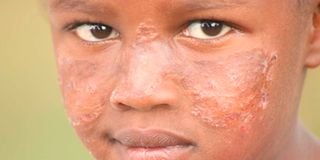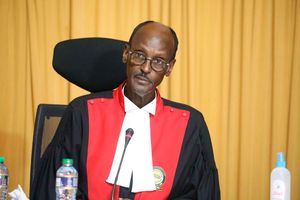Premium
Disease that robbed Baby Sharon of her smile and confidence

What you need to know:
- The most painful part of Sharon’s life is that every week she has to go for treatment at the Gilgil Sub-County Hospital, where the health officer will give her numerous injections on her face. Yes, her face.
- Sharon is not alone. A number of Gilgil residents have been diagnosed with leishmaniasis, which is transmitted through the bite of a female sand fly.
In the remote village of Gitare in Gilgil Sub-County at the border of Nakuru and Nyandarua counties, Sharon Wanjiku, 7, is grappling with a condition that has robbed her of her smile, confidence and happiness.
The face of the Pre-Primary 2 pupil is masked with an ugly scar, which is the emblem of her battle with cutaneous leishmaniasis.
Sharon has to grapple with ridicule and stigma from the community because of her scarred face — a situation her mother Teresia Wanjiru says has lowered the quality of her life and hampered her pursuit of education.
“The disease has denied her a chance to live normally like other children, which has really disturbed me,” says Ms Wanjiru.
The most painful part of Sharon’s life is that every week she has to go for treatment at the Gilgil Sub-County Hospital, where the health officer will give her numerous injections on her face. Yes, her face.
The injections, given only at the Gilgil facility, are the only known primary treatment for cutaneous leishmaniasis — a parasite-caused skin disease that has plagued hundreds of residents of Sogonoi, Utut and Kambi Turkana villages in Gilgil.
It has been six years since Sharon was diagnosed with the disease. Since then, mother and daughter have been moving from one hospital to another in search for a cure. They have even been to herbalists, but no treatment has worked.
Sharon is not alone. A number of Gilgil residents have been diagnosed with leishmaniasis, which is transmitted through the bite of a female sand fly.
There is no concrete data on leishmaniasis in Kenya. World over, the disease has not received the attention it deserves, leading to the World Health Organization (WHO) classifying it as a neglected tropical disease.
In Kenya, Gilgil Sub-County Hospital is probably the only one that specialises in the treatment of the disease — which is done through injections administered on Thursdays, its clinic days for the disease. However, the government does not stock or supply the required drug and the hospital relies on donors such as the Drugs for Neglected Diseases Initiative.
Depending on the size and number of lesions, affected persons receive up to 100 injections on one treatment session.
“The injections are painful. The pain is of unimaginable magnitude and you have to receive up to 20 of those, right on the ulceration point. And you will do this for up to 10 years,” Ms Wanjiru says.
Ms Florence Nyokabi, the officer in charge of the programme at the hospital, says the treatment involves injecting sodium stibogluconate to each lesion to kill the parasite. The officer acknowledges that the injections are painful, which scares most patients so much that some of them return for treatment when the lesions have spread.
And the pain does not end there. Ms Wanjiru says any time Sharon receives injections, she becomes sickly for about three days.
“Her face swells and she becomes irritable. Sometimes she complains of headaches and loses appetite for food. During this time, she does not go to school,” says Ms Wanjiru.
Another patient is Mr Charles Njogu, who hails from Mukenia village. He has been receiving the injections since 2016 but is yet to recover.
The father of three says he got used to living with the condition because it kept recurring after being treated. Mr Njogu has scars on the head, face, and hands; with a fresh infection on the cheek. His five-year-old daughter was also infected. Luckily, she was put on treatment and got healed.
Having received too many injections, doctors recommended that Njogu takes a break from the method and use some oral drugs called “impavido”.
As much as Mr Njogu is determined to maintain the contemporary treatment method, he says it has come with a huge cost. His weekly hospital visits to receive the injections saw him sacked from a resort in Gilgil over “absenteeism”.
He is also unable to efficiently work on his farm because any time he receives injections, the side effects force him to remain grounded in the house for at least three days.
“It is also expensive to travel to Gigil every week since it costs Sh500 to and from the hospital. I am unable to make enough money to feed my family and also get treatment,” says Mr Njogu.
His neighbour Ann Akiru, 72, is also a victim of leishmaniasis. Out of desperation, she says she now applies on her skin a mixture of battery lead, toothpaste, pepper and other herbs.
With over 1,000 people affected, a majority have refused to get treatment while others have stopped attending clinics.
Doctors say the efficacy of the treatment is also not guaranteed as the parasite is said to be developing resistance to medicine.
In a bid to deal with these challenges, the Kenya Medical Research Institute (Kemri) has embarked on research about stem cells, hoping to develop an alternative form of treatment.
Ms Milkah Mwangi, the head of the leishmaniasis research department, notes that apart from the sand fly which is believed to carry the leishmania parasite from one person to another, wild rodents such as rock hyraxes have been identified as animal reservoirs that also facilitate its transmission.
She says the methods currently being used to fight the disease may not be effective since the parasite keeps on mutating. The sodium stibogluconate, which is currently being used for treatment, she says, is discouraged due to its major toxic effects, with its efficacy rates not being guaranteed.
“We established different species of sand flies in Kenya, which were not originally there and which have different breeding sites including soil cracks, under the rocks and mud cracks in the houses,” says Ms Mwangi.
The researcher says the people who are most affected are those from low-income areas in the arid and semi-arid areas. She notes that cases of infections are currently being reported in places where they had never been detected before, for instance Tharaka Nithi, Marsabit, Wajir, Seikuru, Chemolingot, and Kacheliba.
Ms Mwangi says Kemri is seeking to develop a strategy to reduce the use of sodium stibogluconate for the treatment of cutaneous leishmaniasis. “(It) might take some time,” says Ms Mwangi.
Ms Dorcas Wachira, the head of immunology division at the Centre for Technology Research and Development, and who is spearheading the stem cell research at Kemri, says the project began in 2017 after the government acquired the necessary technology for the institute.
Ms Wachira says the research, which is new in Kenya, seeks to develop a drug that can offer alternative treatment that effectively manages wounds without leaving scars.
“We are looking at the possibility of exploring stem cells in the development of a drug that will treat and manage wounds effectively, faster and without leaving scars,” says Ms Wachira, adding that the research is supported by the government of Kenya, Kemri and other partners.
Ms Wachira notes that the team has so far managed to get stem cells from the animal model as well as parasites from the vectors.
Kemri also aims at developing an ointment that can be applied on the affected skin surfaces. Ms Wachira notes that more funding will be required to support the research, which should be through in a years’ time.
WHO estimates that about 95 per cent of the cases of leishmaniasis occur in the Americas, the Mediterranean basin, the Middle East and Central Asia.
This report is produced in partnership with the African Investigative Journalism Conference, an initiative of the Journalism Department at the University of Witwatersrand in South Africa, and the Nation Media Group.



